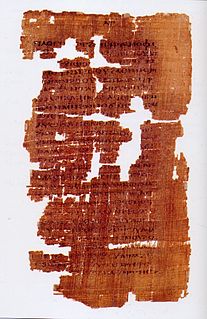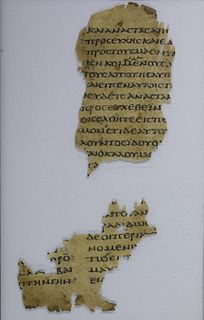Related Research Articles

The Last Supper is the final meal that, in the Gospel accounts, Jesus shared with his apostles in Jerusalem before his crucifixion. The Last Supper is commemorated by Christians especially on Maundy Thursday. The Last Supper provides the scriptural basis for the Eucharist, also known as "Holy Communion" or "The Lord's Supper".

John the Apostle or Saint John the Beloved was one of the Twelve Apostles of Jesus according to the New Testament. Generally listed as the youngest apostle, he was the son of Zebedee and Salome. His brother was James, who was another of the Twelve Apostles. The Church Fathers identify him as John the Evangelist, John of Patmos, John the Elder, and the Beloved Disciple, and testify that he outlived the remaining apostles and was the only one to die of natural causes, although modern scholars are divided on the veracity of these claims.

Judas Iscariot was a disciple and one of the original Twelve Apostles of Jesus Christ. According to all four canonical gospels, Judas betrayed Jesus to the Sanhedrin in the Garden of Gethsemane by kissing him and addressing him as "rabbi" to reveal his identity in the darkness to the crowd who had come to arrest him. His name is often used synonymously with betrayal or treason. Judas's epithet "Iscariot" most likely means he came from the village of Kerioth, but many other possibilities have been suggested.
Edward Morley Callaghan was a Canadian novelist, short story writer, playwright, and TV and radio personality.

Simon the Zealot or Simon the Canaanite or Simon the Canaanean was one of the most obscure among the apostles of Jesus. A few pseudepigraphical writings were connected to him, but Saint Jerome does not include him in De viris illustribus written between 392 and 393 AD.

Jude was one of the Twelve Apostles of Jesus according to the New Testament. He is generally identified with Thaddeus, and is also variously called Jude of James, Jude Thaddaeus, Judas Thaddaeus or Lebbaeus. He is sometimes identified with Jude, the brother of Jesus, but is clearly distinguished from Judas Iscariot, the apostle who betrayed Jesus prior to his crucifixion. Catholic writer Michal Hunt suggests that Judas Thaddaeus became known as Jude after early translators of the New Testament from Greek into English sought to distinguish him from Judas Iscariot and subsequently abbreviated his forename. Most versions of the New Testament in languages other than English and French refer to Judas and Jude by the same name.

Emmaus is a town mentioned in the Gospel of Luke of the New Testament. Luke reports that Jesus appeared, after his death and resurrection, before two of his disciples while they were walking on the road to Emmaus.

In Christianity, Holy Wednesday commemorates the Bargain of Judas by a clandestine spy among the disciples. It is also called Spy Wednesday, or Good Wednesday, and Great and Holy Wednesday.

Mark 14 is the fourteenth chapter of the Gospel of Mark in the New Testament of the Christian Bible. It contains the plot to kill Jesus, his anointing by a woman, the Last Supper, and his predictions of his betrayal and Peter's three denials of him. It then begins the Passion, with the garden of Gethsemane, Judas' betrayal and Jesus' arrest, followed by Jesus' trial before the Sanhedrin and Peter's three denials of Jesus.

The Gospel of Judas is a non-canonical Gnostic gospel. The content consists of conversations between Jesus and Judas Iscariot. Given that it includes late 2nd-century theology, it is widely thought to have been composed in the 2nd century by Gnostic Christians, rather than the historic Judas himself. The only copy of it known to exist is a Coptic language text that has been carbon dated to 280 AD, plus or minus 60 years. It has been suggested that the text derives from an earlier manuscript in the Greek language. An English translation was first published in early 2006 by the National Geographic Society.

Mark 3 is the third chapter of the Gospel of Mark in the New Testament of the Christian Bible. It relates a conflict over healing on the Sabbath, the commissioning of the Twelve Apostles, a conflict with scribes and a meeting of Jesus with his own family.

Mark 6 is the sixth chapter of the Gospel of Mark in the New Testament of the Christian Bible. In this chapter, Jesus goes to Nazareth and faces rejection by his own family. He then sends his Apostles in pairs to various cities in the region where they also face rejection. Finally, Jesus goes back to the Sea of Galilee and performs some of his most famous miracles, including the feeding of the 5000 and walking on water. This chapter also gives an account of the murder of John the Baptist.

Matthew 27:3 is the third verse of the twenty-seventh chapter of the Gospel of Matthew in the New Testament. This verse returns to the story of Judas Iscariot who, in the previous chapter, had accepted payment to betray Jesus to the Jewish authorities. This verse opens the story of his remorse and death.

Matthew 27 is the 27th chapter in the Gospel of Matthew, part of the New Testament in the Christian Bible. This chapter contains Matthew's record of the day of the trial, crucifixion and burial of Jesus. Scottish theologian William Robertson Nicoll notes that "the record of this single day is very nearly one-ninth of the whole book".

Matthew 26 is the 26th chapter of the Gospel of Matthew, part of the New Testament. This chapter covers the beginning of the passion narrative, which continues to chapter 28, containing the narratives of the Jewish leaders' plot to kill Jesus, Judas Iscariot's agreement to betray Jesus to Caiphas, the Last Supper with the Twelve apostles and institution of the Eucharist, the agony in the garden of Gethsemane and the subsequent vindication of Jesus' predictions, that one of the twelve will betray him, and that he will be disowned by Peter.

John 13 is the thirteenth chapter of the Gospel of John in the New Testament of the Christian Bible. The "latter half" or "closing part" of John's Gospel commences with this chapter. The nineteenth-century biblical commentator Alexander Maclaren calls it "the Holy of Holies of the New Testament" and the "most sacred part of the New Testament", as it begins John's record of the events on the last night before the crucifixion of Jesus Christ, emphasising Jesus' love for His disciples, demonstrated in the service of washing their feet, and His commandment that they love one another in the same way. The author of the book containing this chapter is anonymous, but early Christian tradition uniformly affirmed that John composed this Gospel.

John 18 is the eighteenth chapter of the Gospel of John in the New Testament of the Christian Bible. This chapter records the events on the day of the crucifixion of Jesus Christ, starting with his arrest on the evening before, which in Jewish calculation would form part of the same day. Saint Peter's three denials of Jesus are interwoven into the narrative concerning Jesus' trials.

Luke 22 is the twenty-second chapter of the Gospel of Luke in the New Testament of the Christian Bible. It commences in the days just before the Passover or Feast of Unleavened Bread, and records the plot to kill Jesus Christ, the institution of the Lord's Supper, Jesus' arrest and his trial before the Sanhedrin. The book containing this chapter is anonymous, but early Christian tradition uniformly affirmed that Luke the Evangelist composed this Gospel as well as the Acts of the Apostles. This chapter initiates this gospel's passion narrative: according to Eric Franklin, if the apocalyptic discourse in chapter 21 "bases all its thought upon the reality of the Kingdom", it also "leads directly into the passion narrative [which] shows how it was established".

The anointings of Jesus’s head or feet are events recorded in the four gospels. The account in Matthew 26, Mark 14, and John 12 takes place on the Holy Wednesday of Holy Week at the house of Simon the Leper in Bethany, a village in Judaea on the southeastern slope of the Mount of Olives. an In Matthew and Mark, he is anointed by an unnamed woman. In John, the woman is identified as Mary of Bethany, the sister of Martha and Lazarus. The event in Luke features an unknown sinful woman, and is in the northern region, as Luke 7 indicates Jesus was ministering in the northern regions of Nain and Capernaum. The honorific anointing with perfume is an action frequently mentioned in other literature from the time; however, using long hair to dry Jesus's feet, as in John and Luke, is not recorded elsewhere, and should be regarded as an exceptional gesture. Considerable debate has discussed the identity of the woman, the location, timing, and the message.

In Christian theology and ecclesiology, the apostles, particularly the Twelve Apostles, were the primary disciples of Jesus according to the New Testament. During the life and ministry of Jesus in the 1st century AD, the apostles were his closest followers and became the primary teachers of the gospel message of Jesus. There is also an Eastern Christian tradition derived from the Gospel of Luke of there having been as many as seventy apostles during the time of Jesus' ministry.
References
- ↑ "The Greatest Literature of All Time - Morley Callaghan". www.editoreric.com. Retrieved 2016-01-27.
- ↑ Mountford, C. H. (January 1984). "Review:A TIME FOR JUDAS". CM. 12 (1).
- ↑ "A TIME FOR JUDAS by Morley Callaghan | Kirkus Reviews". Kirkus Reviews. Retrieved 2016-01-27.
- ↑ McPherson, Hugo. "Morley Callaghan". The Canadian Encyclopedia. Retrieved 2016-01-27.